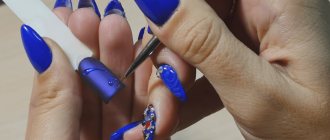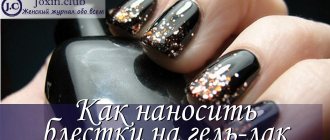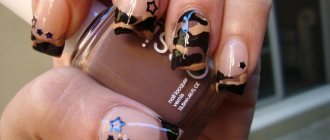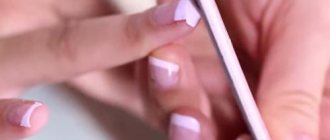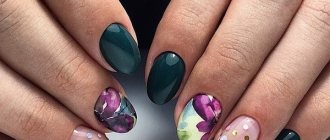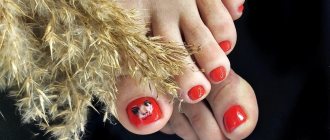Hello, dear readers! In today's article we want to tell you about an amazingly beautiful material for nail art - yuca flakes. The Japanese word “yuki” means snow, which very accurately and expressively conveys the appearance of the design with these sparkles. On nails they really resemble a veil of colored snow shining in the sun or shimmering under the moonlight. With their help, you can realize your brightest ideas and create unique nail art. In this article we will tell you how to apply yuca flakes, as well as offer design options and reveal the little secrets of an airy-light manicure.
Yuca flakes or “chameleon” - what is it?
Holographic sparkles sparkling in all colors, reminiscent of the boundless beauty of space or a sparkling sheet of snow, literally burst into the world of nail art a couple of years ago, becoming a real hit of 2022. Since then, manicure with them has invariably remained popular, both among professional manicurists and among amateurs who, using modern materials, create real masterpieces on their nails.
Yuca flakes are small and very thin metallized plates of various shapes and colors that can be ground, turning into shiny stars, or transferred to nails without rubbing, creating unusual voluminous compositions. They are a rub-in, a pigment, and a coating at the same time.
Yuki changes and expands the color range of gel polish, acrylic and any other coating. With them you can create countless nail designs. The amazing beauty of yuca flakes is difficult to describe in words. A photo or video camera also cannot convey it fully. They need to be seen “live”.
Where to buy
The pigment is only gaining its popularity. You can buy yuca flakes in the nail department, where you can find polishes, tools and materials for manicure. If you couldn’t find a jar with magic scales in your cosmetic store, you can order it in a themed online store.
The pigment is available from the following manufacturers:
- TNL;
- NailTes.
TNL's yuca flakes come in the following shades:
- rose quartz;
- cosmic amethyst;
- volcanic Visuvian;
- mysterious fluriite;
- elegant jade;
- sensual peridot;
- incredible bismuth;
- Burmese tourmaline;
- mysterious lapis lazuli;
- Ural jasper;
- fire opal;
- bold malachite;
- shimmering titanite;
- cold emerald.
Distinctive features
How are flakes different from regular rub? When used, the latter is ground into pearl dust, and the yuki is cut into flat tiny layers, similar to the thinnest plates of mica. Light is refracted and reflected from many surfaces, creating an impressive holographic shimmer effect. It is for these optical properties that yuca received its second name - “chameleon flakes”.
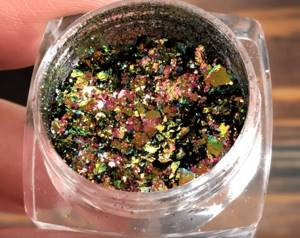
These particles, as weightless as dust, can rightfully be called a pigment - the flakes have a rich color.
Shape, length and health of nails. Restrictions on use for yuca.
Snow rub is best applied and worn on the surface without stickiness.
Of course, the most spectacular look can be achieved by using mica with a galactic glow alone on colored shellac or gel, on very long nails. Thanks to the pronounced arch, the transition from color to color will appear more clearly, the manicure will sparkle and shimmer like the northern lights. However, even with a length “below zero” you should not deprive yourself of pleasure. Use vinyl stencils or mix mica in a topcoat for gel polish, and do French or painting, depict a mosaic or broken glass. There are no restrictions on creativity, you just need to remember the textural features of yuca and present them as spectacularly as possible.
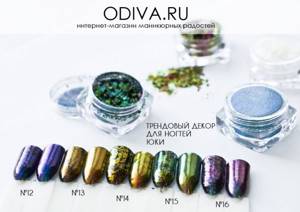
How to use it correctly
Yuki can be applied to almost any coating - acrylic, gel, regular polish, gel polish, topcoat. Before moving directly to the technique of applying flakes, let's focus on general important features that should be taken into account.
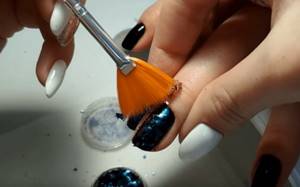
- When handling flakes, it is advisable not to yawn, sneeze or talk loudly. They are exceptionally light and volatile, so if you accidentally sneeze, the flakes will not be distributed throughout your entire nail, but throughout your room.
- Whatever application method you choose, it is important to use a coating with sufficient tack. The stickier the surface, the better the flakes will stick.
- For the yuki layer, it is better to use a material that takes a long time to dry. If you rub yuca flakes onto a quickly setting surface, you may not have time to complete the job and your manicure will be ruined. For example, if you want to apply flakes to an acrylic coating, then when creating it it is better to use a monomer that provides a fairly slow hardening.
- Typically, yuca flakes are applied to gel polish, but if necessary, regular polish can be used. In any case, it is important to fix the manicure with two or three layers of top coat so that the surface is smooth and the scales do not protrude.
- When working with yuki, craftsmen often use dark colors for the main coating: holographic scales look most impressive on them. Of course, you can experiment with light shades. Especially if you have already gained some experience with yuki, then it will be easier for you to come up with a profitable design.
- Before applying the top coat, it is advisable to treat the ends of glitter-decorated nails with a buff.
- If you use the same brush over and over, be sure to remove any remaining flakes before applying the finish coat. Otherwise, yuca particles will get into the top and as a result you will not be able to properly cover the nail surface.
Marmalade for nails – melange
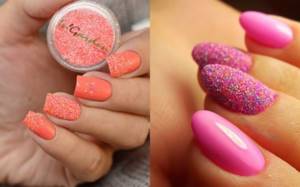
Marmalade for nails or melange - colored sand crystals. There are colored, white with or without sparkles. In addition, marmalade comes in different sizes, which makes the effect of candied nails more or less expressive.
To create a sweet nail effect, apply a base and color. Cover everything with top coat and sprinkle marmalade on the wet layer. Dry everything in the lamp. There is no need to cover with an additional layer of finish, so as not to spoil the effect.
Marmalade is produced, for example, by Irisk and Ingarden.
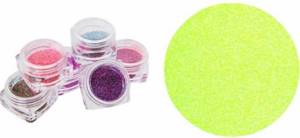
Application technology
To capture and distribute flakes over the nail surface, you can use a flat or fan fluffy brush or sponge.
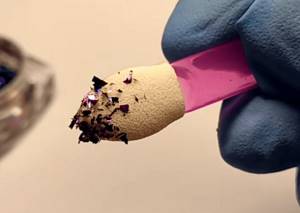
A rubbing applicator is also suitable. You can also just work with your finger. It is convenient to form drawings or individual small design elements with a pencil for laying out broths and rhinestones, a thin brush or other similar tool.
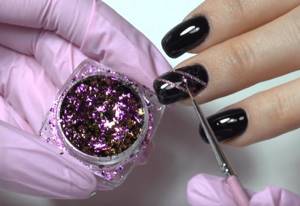
Yuca flakes can be applied to the nail surface in two ways:
Separate flakes

- We collect yuki onto a brush and distribute it over the surface of the nail. You can apply very little flakes or stretch them over the entire surface, or you can evenly fill the entire nail with them - at your discretion.
- With this method, we do not rub the flakes into the sticky layer, but press them to the nail surface with light “trampling” movements of the brush.
- Then, using the same brush, carefully smooth out all the unevenness. Due to the fact that the flakes are very thin, they fit perfectly, do not bulge at all and look very impressive. The result is a magnificent rainbow mosaic.
- In order for our yuks to last without flying off or peeling off the nails, it is recommended to cover them with a double layer of topcoat, making sure to seal the ends. Don’t forget to dry each layer of top coat in a lamp.
The finishing coat not only secures the entire manicure, but also gives it the final shine - as you know, any design elements, including sparkles, kamifubuki, and flakes, always begin to shine brighter under the top coat.
By rubbing
With this method, you need to rub in the yuca like a pigment - then they lie flat and completely cover the nail.
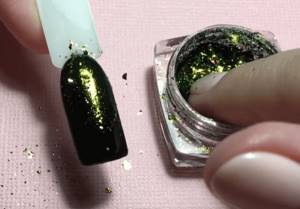
- We take more flakes onto the brush and apply them to the sticky layer with light tapping movements. Our task is to completely cover the nail surface with flakes.
- Using a sponge or finger, smooth out all the unevenness, rubbing all the particles into the sticky layer.
- To consolidate our design, we also cover the nails with two layers of top coat, not forgetting to seal the ends and dry them in a lamp.
Both options are good and which one to choose is up to you or your clients to decide.
Design options
Magically beautiful yuca flakes can create countless nail designs.
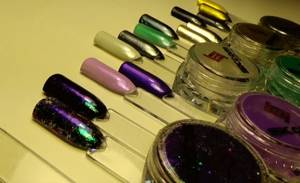
You can make an interesting, mirror rub, ombre or gradient; lay them out like marble textures or create other diffuse effects. Yuca flakes look great under both glossy and matte topcoats.
Specialty stores sell not only yuca flakes in all the colors of the rainbow, but also silver, gold and holographic flakes. Shiny and elegant, they are ideal for any special occasion, for example, for the bright New Year holidays.
It is not at all necessary to apply yuca to the entire surface of the nail. You can decorate only part of the nail plate with flakes, use stencils and stamping, and also combine both methods of applying flakes in a manicure. The gradient with sparkles of various colors also looks incredibly beautiful. There are no strict limits here - yuca flakes will help you implement any of the most daring nail design ideas.
Note: To create an even, glossy layer with a holographic effect, it is best to use a brush - any one that is convenient. It is perfect for both full application and for creating a gradient and stretching. Due to the softness of the brush, the effect of strong rubbing disappears, as a result the surface acquires a more embossed texture.
Photo gallery
We bring to your attention a series of photos with various nail designs made using magic flakes.
